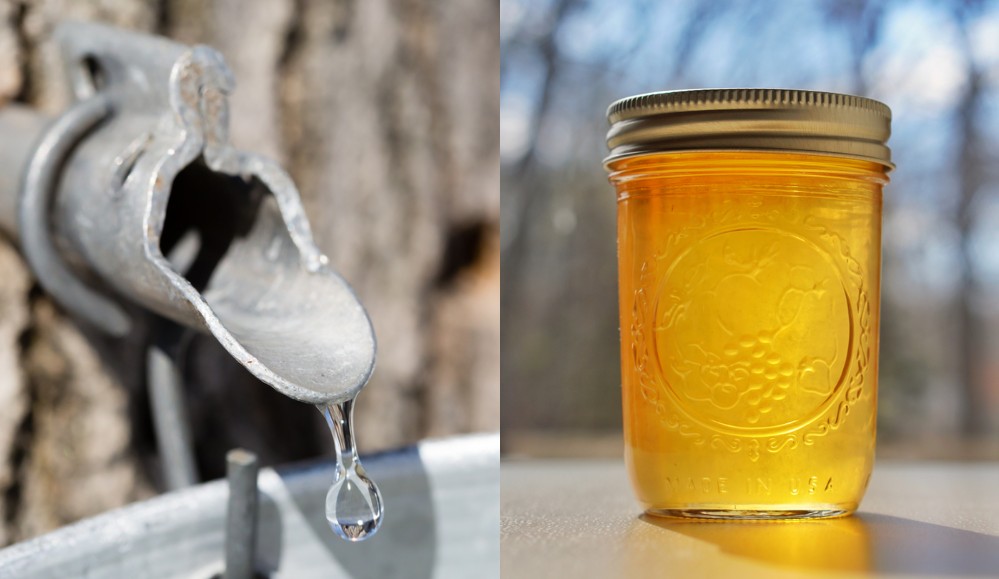Maple Syrup Time!
Tapping for Liquid Gold!
Article by Ruth Wright ~ RTHS Member

It’s that time of year again. As days get warmer and nighttime temperature continue to drop below 0°, conditions are perfect for collecting sap from the maples and transforming it into delicious sticky, gooey, yummy maple syrup, often referred to as ‘liquid gold’.
Canadians love this treat; we slather it on pancakes, porridge, ice cream and more. It’s poured over snow to make maple taffy, formed into maple sugar candy, and finds its way into untold number of sauces or marinades and other recipes. It’s also used as a substitute for sugar.
Canada Leads the Way
Canada accounts for 75% of the world’s production of maple products, amounting to over 61 million kg in 2020. While Quebec is the largest producer, and Lanark County claims to be the “Maple Syrup Capital of Ontario,” maple syrup can be produced wherever Maple trees are found.
A Little History
The Indigenous Peoples of North America were making use of maple sap long before Europeans arrived and sampled their wares. Their legends include the story that Chief Woksis of the Iroquois found the sweet (syrup) when he threw his tomahawk at a maple tree in the cold of winter. The next day, the sun warmed the sap inside the tree, and from the hole sprung forth the tasty sap. The Mi’qmaw, Haudenosaunee and Anishinaabe Peoples were masters of collecting and ‘distilling’ sap. At first, the sap was frozen and the ice was removed from the top, leaving the sweet sap underneath. André Thevet wrote about maple sugaring when describing the voyages of Jacques Cartier in 1557, and Marc Lescarbot described the collection and ‘distillation’ of sap in 1606.

Maple syrup production began among settlers in the late 1700s and early 1800s. Birch bark bowls were first replaced with wooden troughs made from logs. These were placed under the spiles to collect the sap. (This was a method used by Mr. Edward Boyd of North Gower township, as described in the Tweedsmuir History of Kars.) Later, wooden buckets were hung from wooden spiles hammered into the tree.
The collected sap was boiled over an open fire in huge kettles, evaporating the water and leaving the syrup.

Not Just a ‘Walk in the Bush”
Producing maple syrup was a labour-intensive job, since it takes 40 litres of sap to make 1 litre of syrup. The farmer drove his horses and wagon through the bush to collect the sap, take it back to a sugar shack, and boil it in a big evaporator, heating usually with wood.
In recent times, plastic piping is used and gravity moves sap from the trees to collection spots. From there, reverse osmosis is frequently used to eliminate about 50% of the water in the sap, which reduces the amount of boiling time required in the evaporator to finish transforming it into syrup.

Maple Syrup in Rideau Township
In Rideau Township there were various sugar bushes throughout the years, and some local farmers have sold their product, but usually not on a large scale.
James Craig, who farmed at the edge of North Gower village on Lots 20 and 22, Concession 3, recorded in his diary in the 1860s and 1870s that he and his six sons “tapped trees and made maple syrup.” And Cliff Sheppard (1891-1979) farmed on the highway south of North Gower; the farm included a sugar bush in which for 20 years they tapped a hundred trees. He claimed they made about 200 gallons in a season, and would sell it in Ottawa for $1 per gallon. It costs a little bit more than that these days.
Algie and Cliff Wallace operated a sugar bush in the late 1940s and early 50s and hosted ‘sugaring off’ parties for Kiwanis Clubs from Ottawa. Coral Lindsay also talks a bit about “maple sugar time” in "Kars on the Rideau", and has a few pictures of the process. She says that most farmers tapped about 75 trees, but some with evaporators could tap 300 trees.

Many people tapped trees on their own property and made the sap into maple syrup for their own use. They would boil it in a big pot on top of the wood stove and fill the whole house with steam and the sweet odour of hot maple syrup. It was a lot of work, but the end result was worth it as they had an available supply of syrup to last them through the winter months. Even today many people tap trees on their own property and make syrup for their own use using various techniques for boiling, inside or out.
In 2022, Greg and Tanya Williams operate Carsonby Garden Farms at 5943 Second Line Road, which is probably the biggest maple syrup producer in the Rideau Township region. They tap 600 trees in their sugar bush and extract the water using a reverse osmosis process before boiling it into syrup in their outdoor evaporator. Their maple syrup is sold in various locations throughout the area.

The article below is from the Kemptville Weekly Advance - April 18, 1935

